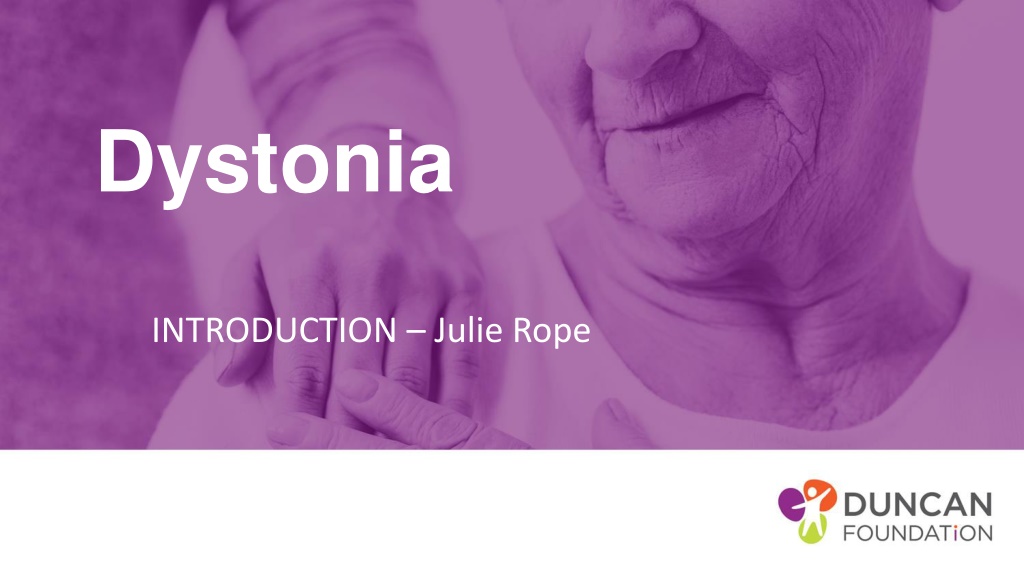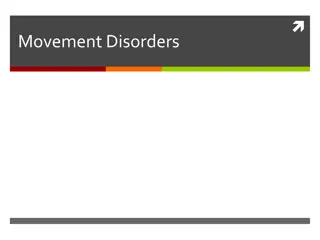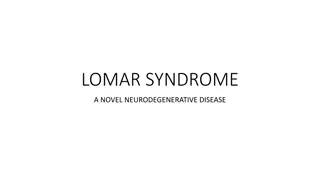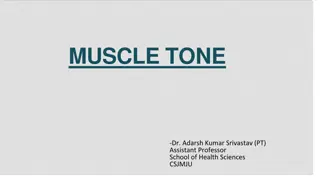Dystonia
Dystonia is a brain circuit disorder affecting muscle control and movement, with origins in the basal ganglia. This disorder involves sustained muscle contractions leading to abnormal postures and pain. Explore the classification, symptoms, and potential causes of dystonia to gain a deeper understanding of this neurological condition.
Uploaded on Feb 19, 2025 | 0 Views
Download Presentation

Please find below an Image/Link to download the presentation.
The content on the website is provided AS IS for your information and personal use only. It may not be sold, licensed, or shared on other websites without obtaining consent from the author.If you encounter any issues during the download, it is possible that the publisher has removed the file from their server.
You are allowed to download the files provided on this website for personal or commercial use, subject to the condition that they are used lawfully. All files are the property of their respective owners.
The content on the website is provided AS IS for your information and personal use only. It may not be sold, licensed, or shared on other websites without obtaining consent from the author.
E N D
Presentation Transcript
Dystonia INTRODUCTION Julie Rope
Objectives To have an understanding of the pathology of the origin of Dystonia To understand the various classification/locations and potential causes of dystonia
Symptom or diagnosis Age location "episodes" that last for minutes or hours, the terms paroxysmal dystonia and dyskinesias are used. task-specific which means that the symptoms occur only when the person is performing a specific task or movement. These forms often involve the fingers and hands or the mouth. Torsion refers to the twisting element of dystonia. It describes muscles contracting against each other.
Dystonia Sustained Sustained muscle contractions that can cause involuntary repetitive movements resulting in abnormal painful painful. The dystonia can be focal include many many body parts. Treatments include oral medications, botulinum toxin injections and DBS. involuntary twisting and abnormal postures that sometimes can be focal (involve only one area of the body) or may A state of abnormal muscle tone resulting in muscular spasm and abnormal posture, typically due to neurological disease or a side effect of drug therapy. The movements may resemble a tremor. Dystonia is often initiated or worsened by voluntary movements, and symptoms may overflow into adjacent muscles.
Pathology 101 primary motor system (pyramidal system) Basal Ganglia (extrapyramidal system) Regulate motion and position Control xs /unwanted mus activity Sensory information Eyes/ears Muscle Output
Dystonia is a brain circuit disorder Basal Ganglia ORIGIN Cerebellar function, sensory processing, motor inhibition, neuroplasticity and somatotopic cortical organisation but the pathology remain largely unclear Cassidy A pathophysiology of idiopathic focal dystonia ACNR 2010 10 14 18 Many parts of the BG Many ways to arrive at dystonia Distribution defines effect Inherited dystonias come from changes in basic cell processes
PAM Our muscles themselves are fine. They re just receiving confusing instructions ( mis-transmissions ), like a mis-coached football team running around in senseless patterns, no offense or defence, as they fail to accomplish coordinated plays let alone score a touchdown! https://dystoniamuse.com/
No inhibition No harmony. deficient inhibition of the antagonist muscles. This can result in co contraction contraction, where the agonist and antagonist muscles contract together. basal ganglia is to balance excitation and inhibition (just like a pair of scales). It is not yet certain whether the problem is with the direct pathway, the indirect pathway or both - ultimately causes the co-contraction or overflow phenomena seen in dystonia. ?shortage of the inhibitory neurotransmitter GABA. At present this is a theory that remains unproven; however, one of the treatments for dystonia, which helps in some cases, is to prescribe medications that increase the quantity of GABA such as benzodiazepines, gabapentin or baclofen. Courtesy of http://www.dystonia.org.uk/ co- -
QOL Mobility Mobility Daily activities Daily activities Pain Pain uncommon in early stages cervical dystonia 75% Mental Health Mental Health 65% mod or s. anxiety or depression. exacerbate symptoms. Employment Employment status. 69% reduced productivity, 31% reduced hours or responsibilities 19% reported unemployment as a result of their condition (Molho 2009) Gudex 1998 Social life Social life 75% Self Self- -conscious conscious 80% (Dystonia Society 2011) 64% 53%
Dystonia is Complex CHRONIC ILLNESS DEPRESSION FATIGUE ANXIETY ISOLATION (impact) NEGATIVE BODY CONCEPT SENSE OF DISFIGUREMENT FUNCTIONAL DISABILITY (predictors) INTERVENTION TO MODIFY- IMPACT QOL QOL MENTAL HEALTH
Classification Areas affected generalised, focal, multi focal, segmental, hemi-dystonia Origin primary idiopathic out of the blue 50%, inherited ?precise cause, further classified by the gene Secondary acquired disease, environmental, infection, drug, trauma damage to BG And location Cervical = neck, blepharospasm = eyes, writers cramp = hand
Diagnosis History BI (anoxia, trauma, CVA) psychiatric (anti psychotic drugs) No blood test or lab test as chemical/functional Not visible on CT/MRI Exclusion
Cervical Dystonia Patterned, repetitive, and spasmodic or sustained muscle contractions resulting in abnormal movements and postures of the head and neck affect any combination of neck muscles result in jerky head movements periodic or sustained unnatural positioning of the head unnatural positioning of the head (dystonic posturing). head and neck may in jerky head movements or Extrapyramidal system fine tunes to maintain set point CD set point altered so overactive contraction of push pull balance into new set point Cervical Dystonia >Spasmodic Torticollis as may not be spasmodic and may or may not consist of torticollis (head turning) Ostrem J
Types Blepharospasm eye muscle, squinting (1 but usu. 2), affect vision, inc. sunlight, wind, stress, running/ decr. Humming singing, pinching neck F>M, 50y + Artificial tears don t help Botox to the orbicularis Oculi Oromandibular dystonia Jaw musc can t open, clench, grinding Pain, hard to eat, drink, speak ?after dental procedure/trauma Meige syndrome facial mus (pharynx, throat, speech swallow) Blepharospasm + Oromandibular dystonia Inc. sTress/ decr. Sing/hum
Types Spasmodic dysphoria Invol. movements of voice box Add/Abduction Can t talk loud, irregular choppy speech, silent at times CAN scream, laugh without spasm, whisper and sing high pitched Does affect airflow Can have mixed F>M, 30 50 yrs onset Diag. local anaesthetic to vocal cord speech normal Botox alternating one cord at a time Writers cramp Focal dominant hand, ache after a page then onset earlier, may develop into complex and associated with CD/ oromandibular Simple writing only Complex all dexterity tasks (buttons, utensils) Usu. Person swaps hand 50% dev in non dom also Occupational dystonia Job musician spasms/feel heavy and pain Rest and Botox but then weakness and in coordination balance but hard if $
Online resources www.dystoniasociety.com Dystonia Medical Research Foundation (DMRF) Dystonia Medical Research Foundation (DMRF) www.dystonia-foundation.org The Dystonia Society The Dystonia Society http://www.dystonia.org.uk/ National Spasmodic Dysphonia Association (NSDA) National Spasmodic Dysphonia Association (NSDA) www.dysphonia.org Benign Essential Benign Essential Blepharospasm Blepharospasm Foundation (BEBRF) http://www.blepharospasm.org/ WeMove WeMove (Movement disorders) (Movement disorders) http://www.wemove.org info@dystonia-foundation.org info@dystonia.org.uk nsda@dysphonia.org Foundation (BEBRF) bebrf@sbcglobal.net
Measures QUALITY OF LIFE QUALITY OF LIFE Cranio Cranio- -cervical Dystonia Questionnaire (CDQ cervical Dystonia Questionnaire (CDQ- -24) and Short Form 36 (SF 24) and Short Form 36 (SF- -36) 36) Disability Disability Toronto Western Spasmodic Torticollis Rating Scale (TWSTRS) Toronto Western Spasmodic Torticollis Rating Scale (TWSTRS) Functional Disability Questionnaire (FDQ). The FDQ is a 27 item scale to measures the impact of CD on daily functioning Functional Disability Questionnaire (FDQ). The FDQ is a 27 item scale to measures the impact of CD on daily functioning RANGE OF MOVEMENT RANGE OF MOVEMENT ability to perform voluntary movements, with a cervical range of motion meter (CROM) [ ability to perform voluntary movements, with a cervical range of motion meter (CROM) [29 three separate inclinometers to measure AROM in the sagittal, coronal and horizontal three separate inclinometers to measure AROM in the sagittal, coronal and horizontal planesthe are unknown, in a healthy population the CROM is a reliable instrument to measure cervical ROM are unknown, in a healthy population the CROM is a reliable instrument to measure cervical ROM 29]. The CROM is a frame that will be placed on the head with ]. The CROM is a frame that will be placed on the head with planesthe psychometric properties of the CROM in patients with CD psychometric properties of the CROM in patients with CD PAIN PAIN To determine the additional effects of PT on pain, patient are asked to rate their pain on a Numeric Rating Scale (NRS). To determine the additional effects of PT on pain, patient are asked to rate their pain on a Numeric Rating Scale (NRS). DEPRESSION DEPRESSION Beck s Anxiety Index and Beck s Depression Index Beck s Anxiety Index and Beck s Depression Index Severity Severity Tsui Tsui scale measures different aspects of abnormal posture and movements in CD patients scale measures different aspects of abnormal posture and movements in CD patients Clinical Global Impressions Clinical Global Impressions- -Severity of Illness Scale (CGI Severity of Illness Scale (CGI- -S) and the Clinical Global Impression ADDS ADDS arm dystonia scale arm dystonia scale S) and the Clinical Global Impression - - Improvement scale (CGI Improvement scale (CGI- -I). I).
References Bleton J-P, Spasmodic Torticololis. A physiotherapy handbook. 2014, Frison-Roche Cassidy A pathophysiology of idiopathic focal dystonia ACNR 2010 10 14 18 Chan, J. Brin, MF, Fahn, S: Idiopathic cervical dystonia: clinical characteristics. Movement disorders 1991;6(2):119-26 Chronicles of a dystonia muse https://dystoniamuse.com/ Dashtipour K, Lew M. Handbook of Dystonia. 2007: 37-154. Dystonia foundation organisation living with dystonia physical therapy resource Joost van den Dool, et al; Effectiveness of a standardised physical therapy program: study design and protocol of a single blind randomised controlled trial. BMC Neurology December 2013, 13:85 Mueller J, Wissel J Visual biofeedback treatment improves cervical dystonia Department of Neurology, Vivantes Hospital Berlin Spandau, Academic teaching Hospital of the Charit , Berlin Ostrem Jill L. , MD Diagnostic criteria for cervical dystonia: Can botulinum neurotoxin manage, as well as, cure the problem? Professor of Neurology UCSF Department of Neurology Movement Disorder and Neuromodulation Center Bachmann Strauss Dystonia and Parkinson s Disease Center of Excellence Dec 2015 Thong, D, Mayank P and Frei K. Living Well with Dystonia. A patient guide. 2010. National Institute of Neurological Disorders and Stroke Wolfgang H.Jost et al: Rating scales for cervical dystonia: a critical evaluation of tools for outcome assessment of botulinum toxin therapy, J Neural Transm. 2013 Mar; 120(3): 487 496.
THANK YOU Julie Rope on behalf of the Duncan Foundation









